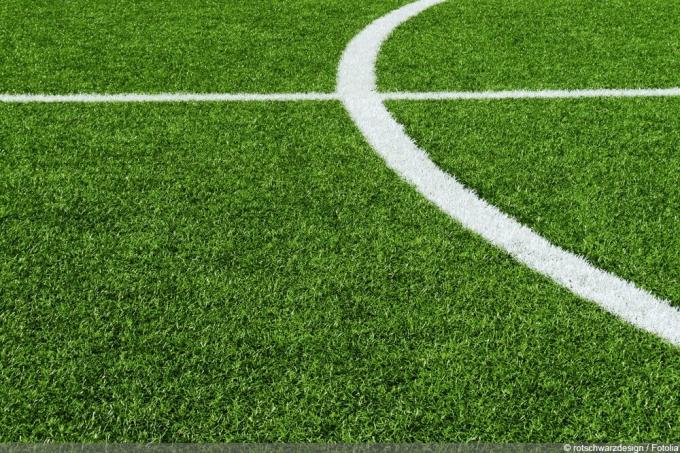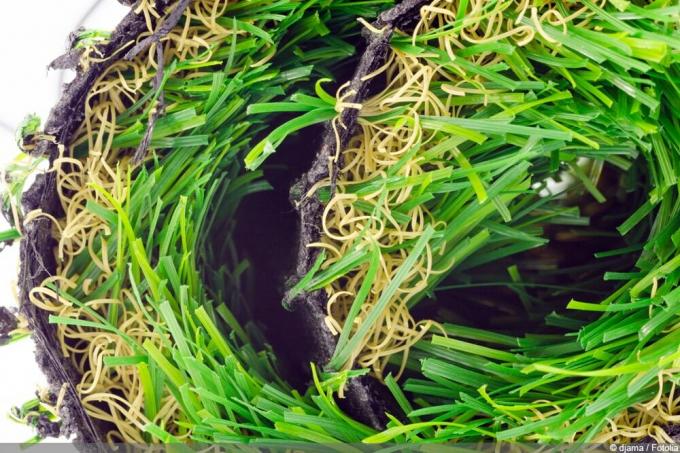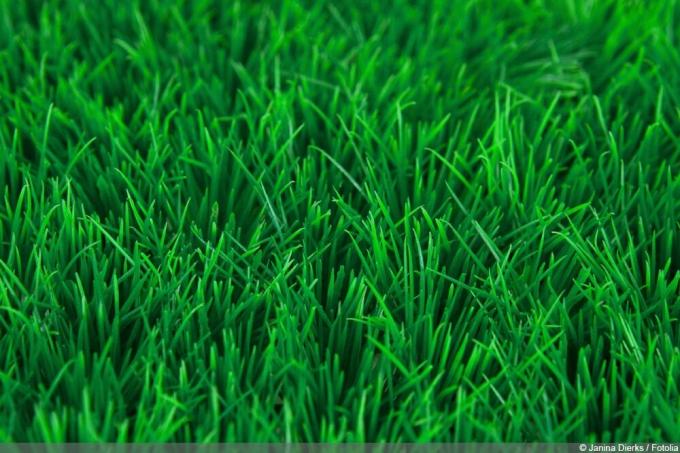

Table of contents
- Advantages: lawn carpet vs. real lawn
- Lay the lawn carpet yourself?
- Materials needed
- Step 1: Subfloor preparation
- Step 2: Trim the lawn carpet
- Step 3: Unroll
- Step 4: Glue Preparation
- Step 5: Cutting the Edges
- Last step: erecting the artificial turf
Nowadays there are lawn carpets that are optically exactly like a real lawn and can hardly be distinguished from it at first glance. This makes artificial turf more and more popular. You can install it yourself quite easily. You can find out everything you need to know about this and how to proceed step by step in the guide.
Advantages: lawn carpet vs. real lawn
Real Lawn
Real lawn is demanding in terms of care if it is to serve as a visual eye-catcher. He suffers from severe stress, such as when the children romp, especially when he is wet. Weeds want to be pulled, they need regular cuts from spring to autumn, they have to be fertilized and occasionally scarified. And if the soil and light conditions are not optimal, it will not thrive.
artificial grass
The lawn carpet, on the other hand, is significantly more robust than normal garden lawns and, depending on the quality standard, also more durable than special lawns.
With this, no turf can be damaged, there is no need to cut the lawn and no more time has to be invested in maintenance. But it is particularly advantageous that it can be used to cover areas where real grass would not stand a chance Conditions do not allow a real lawn due to its quite heavy weight, such as in many places on balconies or roof terraces. But reaping the benefits requires expert preparation, design and processing.
Lay the lawn carpet yourself?
As a rule, artificial turf can be easily laid by anyone without the need for a skilled craftsman. However, you should leave the laying of professional artificial turf to the professionals. These types of artificial turf are mostly used for areas where meticulous work is required, such as golf courses or soccer fields. For normal use on terraces, balconies or in the garden you can use the following Step-by-step instructions make it easy to prepare the substrate, cut it to size and lay it do it yourself.
Materials needed

What you need depends on the nature of the subsoil.
Laying on solid, level ground without soil
- Cutter knife (carpet knife)
- artificial grass glue
- The required amount of sod carpet
- Fastening anchors if required
- measuring tape
- silver or quartz sand
- Coarse broom
Laying on soil instead of real grass:
- Spade when real turf needs to be removed
- Crushed sand or gravel (0/5 grain size)
- vibrating plate
- Long straight board or batten
- weed fleece
- ground anchor
- Lawn Carpet Glue
- silver or quartz sand
- Coarse broom
- measuring tape
Step 1: Subfloor preparation
solid ground
If the subsoil is level and firm, as is usually the case with concrete floors or paved subsoils, this is
cleaned of dirt and all bumps such as small stones. It is best if the substrate is dry before laying. This prevents moisture build-up and makes laying easier.
Loose ground
If you would like to exchange real grass for artificial grass or lay out an area of land with artificial grass, proceed as follows:
- Remove grass, flowers, weeds or similar from the surface of the earth
- Dig up the soil about 10 to 15 centimeters
- Fill in broken sand or gravel (ensure a gap of 2 centimeters between curb stones)
- Compact the layer of sand or gravel with the vibrating plate
- Then scrape off excess with a straight slat or board
- Lay weed fleece over the entire surface - it must be completely smooth and must not have any bumps or folds
- Provide the weed fleece with ground anchors so that it does not slip when the lawn is laid
Step 2: Trim the lawn carpet
Roughly cut the individual strips to size. This makes it easier for you to later adjust the individual lengths precisely, especially with large areas and long strips can be handled better if laid correctly. Leave the ends of the strip in place for the time being and only cut them when you are going to glue them. Only the first attachment point of the individual sheets should end exactly at the house or a curb.
Step 3: Unroll

Place the cut lengths in their place. Make sure that the lengths are laid close together so that when they are later glued together they connect directly to each other without gaps. For a better look, the tracks are rolled away from the house. This is due to the so-called pile direction that artificial turf has. For this reason, the lawn carpet should always be rolled out in straight lines. As soon as it would be at an angle, the existing pile direction would make the look more uneven.
Step 4: Glue Preparation
You have various options for gluing the individual membranes:
- Glue the outer edges together with a 2-component adhesive
- Fix with a seam tape or also called lawn tape (similar to double-sided adhesive tape)
- With the Easyklit system, where Velcro fasteners ensure that the individual panels are held together
2-component adhesive
- Always start from the first track laid out at the beginning
- Apply the glue generously to the outer edges piece by piece
- Connect the artificial grass strips that are next to each other
- After each gluing process, run your hand over the seams so that they are pressed out and leveled
- The outer edge, which does not connect to the next lane, is fixed with ground anchors or glued to curbs or to the solid subsoil
- Do this for each panel until the last panel is glued
Seam tape/lawn tape
- First fix the outermost edge of the lawn using ground anchors or tape
- To use the tape, the lawn edges must be folded inwards by about 30 to 50 centimetres
- If the strips are next to each other, both edges should be folded over
- Place the seam tape/lawn tape in the middle so that it is later covered in equal parts by the right and left sections
- With the double-sided adhesive lawn tape, the lower protective film is first removed from solid surfaces and glued to the surface
- Detach the upper protective film and carefully unfold first one side of the web and then the other side onto the band/tape
- Press firmly on the seams in particular
- Also pay attention to an almost seamless transition between two tracks
- After each gluing process, run your hand over the seams so that they are pressed out and leveled
- Proceed in the same way for all lengths until you have glued the last length
Tip:
Always remove the protective film in the opposite direction to the pile. This means that any blades of artificial grass that may be lying on the floor can be erected.
system
- Prepare the lawn carpet lengths in the same way as when gluing with seam tape or lawn tape
- Fold the panel edges inwards and glue part of the Velcro here
- This should end right at the edge
- Place the opposite part of the Velcro system on the floor
- You can either attach it to a solid surface with a 2-component adhesive or fix it to the gravel/sand layer with fastening anchors
- Fold back the rolled up lawn edges and press firmly
- Make sure the adjacent web is seamless
- There must be no air spaces in which moisture could collect
- However, if there are small gaps, you can use the Velcro system to correct them later at any time
Step 5: Cutting the Edges

Before you glue the edges of the individual sheet ends, they must be cut to size. This applies above all to artificial turf that ends on curbs or house walls. The rest of the strips should already have been optimally laid and glued. This ensures that there is no longer any shifting that could possibly affect the length of the web. To do this, use a cutter or conventional box cutter. Alternatively, you can also use a household knife if it is very sharp. The cut is always made in the pre-modeled areas that can be seen on the back of the lawn carpet.
Last step: erecting the artificial turf
Due to the rolling up and often also as a result of production, the artificial grass blades are often very flattened and do not stand up like real grass. You can easily help here:
- Spread silver or quartz sand on the artificial turf surface (about 5 to 10 kilograms per square meter)
- Sweep the lawn against the direction of the pile with a coarse broom
- Sweep up the sand at the end of the lawn and sweep it up as much as possible
- Remnants of sand sink over time
Tip:
The lawn carpet can also be cleaned with a vacuum cleaner and even a slightly damp mop can be used to remove dust or coarser dirt. Always make sure that you work against the direction of the pile to prevent the artificial grass from being pressed down.
 garden editorial
garden editorial I write about everything that interests me in my garden.
Find out more about terraces and balconies

Sun protection for windy balconies and terraces
Sun protection turns the balcony and terrace into a cool oasis of well-being on hot days. However, if the cozy "outside" is windy, the question arises as to which shade provider will remain intact even in stronger winds.

Balcony privacy screen: 11 privacy screen ideas for the balcony
There are numerous ways to equip your own balcony with a privacy screen. Ideas that are easy to install and can be made of a wide variety of materials are used. Depending on the purpose, they can be used for the front of the balcony or as a side screen.

Laying tiles on the balcony: 6 options
A tile covering makes balconies durable, resilient and, last but not least, easy to clean. But only if you lay the coverings correctly is the success of a lasting nature. Therefore, you should know the common methods before you take action.

artificial grass | Costs, advantages & disadvantages
Artificial grass for the garden can be a wonderful alternative to real grass. However, it also has disadvantages. It should therefore be carefully weighed up whether the advantages or the potential problems outweigh the disadvantages in the individual case. We offer appropriate decision-making aids here.

Lay Bankirai | 7 tips for care and installation
The tropical wood Bankirai has long since become the standard in our homes and gardens. It is mainly used as a floor covering for terraces and balconies. Here's what to look out for when buying, how to lay and care for it correctly.

Lay terrace slabs on earth, grit and sand: instructions
For many homeowners, the terrace is the summer living room. Furniture and potted plants ensure the perfect feel-good ambience. However, this adds up to quite a weight, and the question arises as to whether earth, sand or grit can withstand it.



